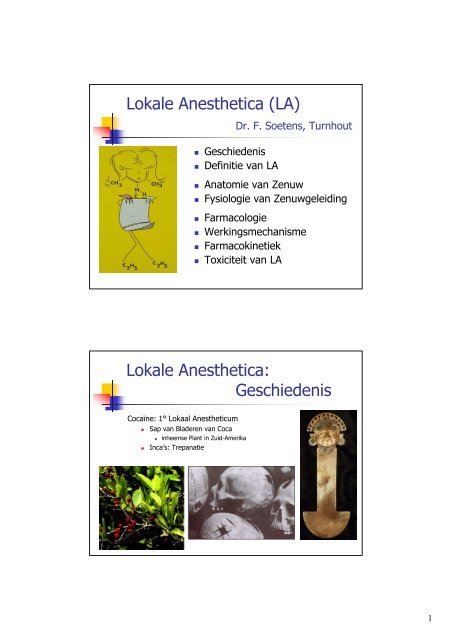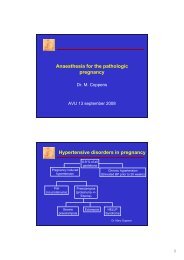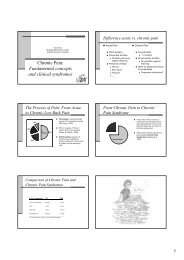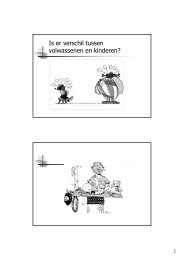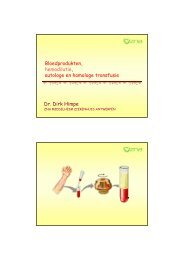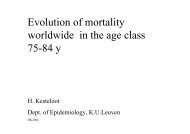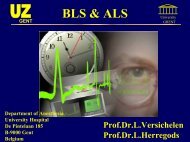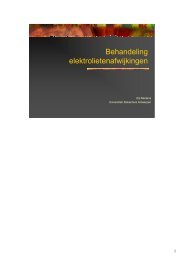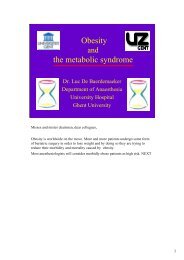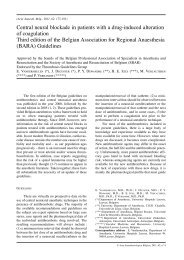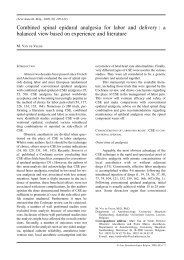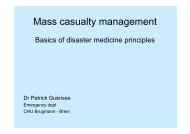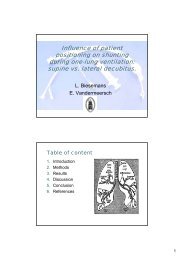Lokale Anesthetica (LA) Lokale Anesthetica: Geschiedenis
Lokale Anesthetica (LA) Lokale Anesthetica: Geschiedenis
Lokale Anesthetica (LA) Lokale Anesthetica: Geschiedenis
Create successful ePaper yourself
Turn your PDF publications into a flip-book with our unique Google optimized e-Paper software.
<strong>Lokale</strong> <strong>Anesthetica</strong> (<strong>LA</strong>)<br />
Dr. F. Soetens, Turnhout<br />
• <strong>Geschiedenis</strong><br />
• Definitie van <strong>LA</strong><br />
• Anatomie van Zenuw<br />
• Fysiologie van Zenuwgeleiding<br />
• Farmacologie<br />
• Werkingsmechanisme<br />
• Farmacokinetiek<br />
• Toxiciteit van <strong>LA</strong><br />
<strong>Lokale</strong> <strong>Anesthetica</strong>:<br />
<strong>Geschiedenis</strong><br />
Cocaïne: 1° Lokaal Anestheticum<br />
• Sap van Bladeren van Coca<br />
• inheemse Plant in Zuid-Amerika<br />
• Inca’s: Trepanatie<br />
1
<strong>Lokale</strong> <strong>Anesthetica</strong>:<br />
<strong>Geschiedenis</strong><br />
• 1860: Isolatie van Cocaïne (Niemann)<br />
• 1884: Cocaïne<br />
• Köller: Anesthesie Oog (topicaal)<br />
• Halsted: Plexus brachialis<br />
• 1898: Bier: Spinale anesthesie<br />
• 1904: Procaïne (Einhorn)<br />
• 1943: Lidocaïne (Löfgren)<br />
• 1957: Bupivacaïne (Ekstam)<br />
• 1996: Ropivacaïne (Ekstam, Sandberg)<br />
• 1999: Levobupivacaïne (Ekstam)<br />
<strong>Lokale</strong> <strong>Anesthetica</strong>: Definitie<br />
Blokkeren de Generatie, Conductie en Oscillaties<br />
van Actiepotentialen in Zenuwvezels<br />
na lokale Toediening<br />
→ Analgesie/ Anesthesie<br />
op een reversibele Manier ↔ Neurolytica (Fenol)<br />
2
Anatomie: Axon of Zenuwvezel<br />
Gemyeliniseerd<br />
niet-Gemyeliniseerd<br />
Schwann Cel + +<br />
1 Schwann Cel 1 Axon 5-10 Axonen<br />
Myeline? +<br />
-<br />
Knoop v. Ranvier + -<br />
Na + -Kanaal Knoop v. Ranvier verspreid<br />
Conductie +++ +<br />
Anatomie: Knoop van Ranvier<br />
• Conductiesnelheid ≈∅<br />
• ↑ Myeline<br />
• Isolatie<br />
• ↑ internodale Afstand<br />
• Thv Knoop van Ranvier<br />
• Geen Myeline<br />
• Passage van Ionen (Na + )<br />
• <strong>LA</strong><br />
3
Anatomie: Classificatie<br />
Klasse Diameter Myeline Internodale Conductie Locatie Functie<br />
Subklasse (µm)<br />
afstand snelheid<br />
(mm) (m/s)<br />
A α 6-22 +++ 1.1 30-120 Efferent naar Spier Motoriek<br />
β 6-22 ++ 30-120 Afferent van Huid<br />
Gewrichten<br />
Tast,<br />
Druk,<br />
Proprioceptie<br />
γ 3-6 ++ 15-35 Efferent naar Spierspoel Spiertonus<br />
δ 1-4 ++ 0.5 5-25 Afferente sensorische Zenuw Pijn (scherp),<br />
Aanraking,<br />
koude Temperatuur<br />
B
Anatomie: Perifere Zenuw<br />
• Axon - Schwann Cel<br />
Endoneurium<br />
• Fasciculus = 500-1000 Axonen<br />
Perineurium<br />
• Perifeer Equivalent BBB<br />
• ≠ Fasciculi = Perifere Zenuw<br />
Epineurium<br />
Epineurale Schede<br />
• 30-70% ∅<br />
Fysiologie van Zenuwgeleiding<br />
Rust Membraanpotentiaal (E m )<br />
• 60-90 mV (Cel negatief)<br />
• Semi-permeabele Membraan<br />
(anions) - • Permeabel K + (Lek-Kanaal)<br />
• Impermeabel Na<br />
+<br />
Anionen<br />
• Na + /K + -ATPase (2 K + -3 Na + )<br />
5
Fysiologie van Zenuwgeleiding<br />
• Depolariserende Stimulus<br />
• Na + -Kanaal opent<br />
• Voltage gevoelig<br />
• Permeabiliteit Na + > K +<br />
• +30 mV: Actiepotentiaal<br />
• Repolarisatie (Herstel Rust E m )<br />
• Na + -Kanaal sluit<br />
• Tijd gevoelig<br />
• K + -Kanaal opent<br />
• Voltage gevoelig<br />
• Na + /K + -ATPase (2 K + -3 Na + )<br />
• Refractaire Periode<br />
Fysiologie van Zenuwgeleiding<br />
6
Electrotonische Conductie<br />
Saltatorische Conductie<br />
Het Na + -Kanaal<br />
• α, β 1 en β 2 Subunit<br />
• α-Subunit<br />
• 4 Domeinen (I, II, III, IV)<br />
• 1 Domein<br />
• 6 α-Helices (S1 → S6)<br />
• Polypeptide Ketens (SS)<br />
8
Het Na + -Kanaal<br />
• Na + -Specificiteit<br />
• SS tussen S5-6 x4 (4P-regio’s)<br />
• Tetrodo- en Saxitoxine (Site 1)<br />
• Activatie Poort<br />
• S4 x4 = Voltage Sensor<br />
• Positief geladen<br />
• Rust E m = negatief: Gesloten<br />
• Depolarisatie E m = positief<br />
→ ConfiguratieΔ in S6: Open<br />
• Inactivatie Poort<br />
• SS van DIII en DIV<br />
• In het Kanaal<br />
• Receptor <strong>LA</strong><br />
• S6 in DI, III en IV<br />
Receptor <strong>LA</strong> S6 in DI, III en IV<br />
9
Farmacologie:<br />
de <strong>LA</strong> Molecule<br />
• Amide en Ester <strong>LA</strong><br />
• Aromatische Ring: Lipofiel<br />
• Amide <strong>LA</strong>: Aniline<br />
• Ester <strong>LA</strong>: Benzoëzuur<br />
• Tertiair Amine: Hydrofiel<br />
• Intermediaire Verbinding<br />
• Amide-Verbinding<br />
= Amine (Aniline) + Carbonzuur<br />
• Ester-Verbinding<br />
= Carbonzuur (Benzoëzuur) + Alcohol<br />
Farmacologie:<br />
Chemische Eigenschappen ≈ Activiteit<br />
• Molecuul Grootte (MW)<br />
• pK a<br />
• Lipofiliciteit<br />
• Proteïne Binding<br />
• Stereoselectiviteit<br />
ti it it<br />
10
Farmacologie<br />
Chemische Eig n : pK a<br />
<strong>LA</strong> pK a %Kation Onset<br />
Zwakke Base: Base/Kation afh v pH/ pK a<br />
(pH = 7.4)<br />
in vivo<br />
Ester<br />
Procaïne 8.9 97% 16<br />
pH = pK a + log <strong>LA</strong> / <strong>LA</strong>H +<br />
Chloroprocaïne 8.7 95% 3<br />
Tetracaïne 8.5 93% 12<br />
LIPOFIEL<br />
HYDROFIEL<br />
Benzocaïne 2.6 0%<br />
Amide<br />
Pil Prilocaïne 7.9 76% 3<br />
pK a = pH → [<strong>LA</strong>H + ] = [<strong>LA</strong>]<br />
Mepivacaïne 7.6 61% 3<br />
Lidocaïne 7.9 76% 3<br />
Ropivacaïne 8.1 83% 7<br />
Bupivacaïne 8.1 83% 7<br />
L-bupivacaïne 8.1 83% 7<br />
Etidocaïne 7.7 66% 3<br />
pH ↓, pK a ↑ → [<strong>LA</strong>H + ]+++<br />
→ tragere Onset<br />
hydrofieler → ↓Penetratie Membraan<br />
Farmacologie<br />
Chemische Eig n : Lipofiliciteit<br />
<strong>LA</strong> MW P n Potency<br />
Ester<br />
Procaïne 236 100 1<br />
n<br />
octanol/buffer Partitiecoëfficiënt (P n )<br />
≈ # en Grootte Alkyl Groepen op<br />
Amine/ aromatische Ring (MW)<br />
Chloroprocaïne 271 810 3<br />
Tetracaïne 264 5822 8<br />
Benzocaïne 165 132<br />
Amide<br />
Prilocaïne 220 129 1,8<br />
Mepivacaïne 246 130 1,5<br />
Lidocaïne 234 366 2<br />
Ropivacaïne 274 775 6-7<br />
Bupivacaïne 288 3420 8<br />
L-bupivacaïne 288 3420 8<br />
Etidocaïne 276 7317 8<br />
↑→ Sequestratie/ Depot in Myeline/ Vet<br />
→ tragere Onset, ↑ Duur<br />
→ Na + -Kanaal Receptor Affiniteit<br />
Membraan Expansie<br />
→ ↑ Potency<br />
11
Farmacologie<br />
Chemische Eig n : Proteïne Binding<br />
• Bloed<br />
• α 1 -zure Glycoproteïne:<br />
hoge Affiniteit - lage Capaciteit<br />
↑ postoperatief<br />
myocardinfarct<br />
↓ neonaat<br />
• Albumine:<br />
lage Affiniteit - hoge Capaciteit<br />
• Vrije Fractie<br />
• farmacologisch actief<br />
• ↑: ↓ Lipofiliciteit / ↑ pK a<br />
↑ totale Dosis<br />
Farmacologie<br />
Chemische Eig n : Proteïne Binding<br />
• Gebonden Fractie = Depot ≈ ↑ Duur (cfr Lipofiliciteit)<br />
Duration of Plexus Brachialis Blockade (h)<br />
12
Farmacologie:<br />
Chemische Eig n : Stereoselectiviteit<br />
• Isomeren Structurele Isomeren: Bindingen tussen Atomen<br />
≠<br />
Stereo-Isomeren: Bindingen tussen Atomen =<br />
Schikking in Ruimte op 1 C-Atoom ≠<br />
• 4 ≠ Groepen C-Atoom (asymmetrisch C-Atoom)<br />
2 mogelijke ruimtelijke Schikkingen:<br />
Spiegelbeeld = Enantiomeren<br />
optisch actief: gepolariseerd Licht: R- of S-<br />
50/50: racemisch Mengsel (optisch inactief)<br />
Farmacologie:<br />
Chemische Eig n : Stereoselectiviteit<br />
• Alle ecommerciële ecëe<strong>LA</strong> zijn racemische eMengsels<br />
gses<br />
• Uitz: Lidocaïne (achiraal), Ropivacaïne en L-Bupivacaïne<br />
• Belang?<br />
• = Fysicochemische Eig n (MW, pK a , Lipofiliciteit)<br />
• ≠ Effecten op Potency, Proteïne Binding, Farmacokinetiek, Toxiciteit<br />
• Cardiotoxiciteit: L-Bupivacaïne < racemisch Bupivacaïne<br />
• Vasoconstrictie: Levo > Dextro<br />
13
Activiteit ↑<br />
• Dosis ↑: snellere Onset, ↑ Duur, ↑ Diepte Blok<br />
• Onset: Chloroprocaine 3% > Lidocaine 2% (ondanks pK a 8.7 vs 7.9)<br />
• Zwangerschap: ↑ Spreiding, ↑ Diepte Blok (Epidurale/Spinale)<br />
• Mechanische Factoren? Ook in 1° Trimester!<br />
• ↑ epidurale venen: ↓ CSF/ epidurale Ruimte<br />
• Hormonale Δ (Progesteron)<br />
• Additieven:<br />
• Adrenaline<br />
• HCO 3<br />
• Opiaten<br />
Activiteit ↑<br />
• Adrenaline: snellere Onset, ↑ Duur, ↑ Diepte Blok<br />
• Farmacokinetisch: alle <strong>LA</strong> geven VD (+ Adr.: ↓ vasc. Absorptie →↑ intraneurale [<strong>LA</strong>])<br />
• Farmacodynamisch: α 2 -Agonist in RM<br />
• Alkalinisatie: snellere Onset (?)<br />
• <strong>LA</strong>: slecht oplosbaar in H 2 O: HCl zouten: ↓ pH<br />
• commerciële Oplossing (3.9-6.5); +Adr (3.2-4.2) → Base = 3%<br />
• + NaHCO 3 : pH 6-8 (cave Precipitatie) → Base = 10%<br />
• Opiaten: snellere Onset, ↑ Duur, ↑ Diepte Blok<br />
• Epiduraal, Spinaal; NIET bij Intra-articulair en perifeer Zenuwblok<br />
• Spinale en Supraspinale Mech<br />
• M<strong>LA</strong>C (Minimum Local Analgesic Concentration): + Sufentanil: Reductie [<strong>LA</strong>] 4-10x<br />
14
Activiteit ↓<br />
• Inflammatie:<br />
• Tandarts: Falen van lokale Verdoving bij Abces<br />
• Mech: Farmacokinetisch: pH ↓ (↑ BH + ), Oedeem, Bloedflow ↑<br />
Farmacodynamisch: Activatie van perifere NMDA-R<br />
• Tachyphylaxie:<br />
• Injectie van dezelfde Dosis <strong>LA</strong> → ↓Effectiviteit<br />
Niet als dosing Interval kort is; Pijn is belangrijk!!!<br />
• Mech: Farmacokinetisch:<br />
↓ Opname <strong>LA</strong>, ↑ Klaring uit Zenuw<br />
Farmacodynamisch:<br />
≈ spinal Cord Sensitisatie (Hyperalgesie, Activatie NMDA-R)<br />
R/ NMDA R-Antagonisten<br />
NO-Synthase Inhibitoren<br />
• Ehlers-Danlos Syndroom - Roodharigen<br />
Werkingsmechanisme van <strong>LA</strong><br />
TTX<br />
inside inside<br />
Na + -Kanaal<br />
Benzocaïne<br />
• Membraanexpansie<br />
→ Δ Na + -Kanaal<br />
• Benzocaïne<br />
enkel Base<br />
• Receptor: Inw. Porie Na + -Kanaal<br />
2 Vormen:<br />
• Base: in Membraan<br />
lateraal naar R<br />
door Membraan naar R<br />
• Kation: bindt Receptor (-)<br />
Klassieke <strong>LA</strong>: Base - kation<br />
15
Werkingsmechanisme van <strong>LA</strong><br />
BINDING <strong>LA</strong> - Na + -Kanaal<br />
1. Open/ Geïnactiveerd > Rust<br />
• Guarded Receptor Model<br />
• Open: > Bindingsplaatsen<br />
→↑ Blok Na + -Kanaal<br />
• Modulated Receptor Model<br />
• Geïnactiveerd: ↓ Dissociatie<br />
2. Stereospecifiek<br />
→↑ Blok Na + -Kanaal<br />
• R > S Enantiomeren<br />
Werkingsmechanisme van <strong>LA</strong><br />
Open/ Geïnactiveerd > Rust<br />
• Hoge Dosis <strong>LA</strong>: ↓ I Na 100%<br />
• Subklinische Dosis <strong>LA</strong><br />
• Lage Stimulatiefrequentie<br />
• ↓ I Na 30%<br />
• Tonische Inhibitie (30%)<br />
• Stimulatiefrequentie >5Hz<br />
• ↓ I Na 75% (of ↑ Blok tot 75%)<br />
• Fasische of Frequentieafh. Inh.<br />
• ↑ Stimulatiefrequentie → ↑Blok<br />
• Benzocaïne geen Fasische Inh.<br />
• Klinisch: Use-Dependent Block<br />
16
Werkingsmechanisme van <strong>LA</strong><br />
Werkingsmechanisme van <strong>LA</strong><br />
TTX benzocaïne<br />
• Uitw. Porie Na+ -Kanaal<br />
(Site 1)<br />
Biotoxines<br />
enkel Kation<br />
inside inside<br />
• Saxitoxine<br />
(Algen, Schaaldieren)<br />
• Tetrodotoxine<br />
(Bacteriën, Kogelvis)<br />
• “Finding Nemo”<br />
• Dodelijke Sushi Delicatesse<br />
• Toxisch +++<br />
17
Inhibitie Na + -Kanaal<br />
• <strong>LA</strong><br />
• Biotoxines<br />
• Inhalatie <strong>Anesthetica</strong><br />
• Ca ++ -entry-Blokkers<br />
• α 2 -Agonisten<br />
• Tricyclische Antidepressiva<br />
• Substance P Antagonisten<br />
• Ketamine<br />
• …<br />
• <strong>LA</strong> Effecten<br />
Werkingsmechanisme van <strong>LA</strong>:<br />
Alle Zenuwvezels = Gevoelig?<br />
• Klinisch (Spinale Anesthesie): t° → scherpe Pijn → Druk<br />
• C > A?<br />
• Differentieel Blok: dunne gevoeliger dan dikke Zenuwvezels<br />
Experimenteel: A ≤ C<br />
• Verklaring?<br />
1. Physicochemische Eig n : Amide, ↑ pK a , ↓ Liposolubiliteit<br />
• Ropivacaïne vs Bupivacaïne vs Etidocaïne<br />
• ↓ Penetratie gemyeliniseerde (Aα)-Vezels<br />
• Vnl C-Vezels<br />
• Differentieel Sensorisch Blok (Obstetrie, postOP)<br />
2. Plaats van Zenuwvezel in de Zenuw<br />
3. Lengte Principe<br />
19
Plaats Zenuwvezel in de Zenuw<br />
Mantle Bundle<br />
Core Bundle<br />
Lengte Principe (1)<br />
“Kritische Lengte” Zenuw moet in <strong>LA</strong> baden<br />
Gemyeliniseerde Zenuwvezel<br />
• Hoge [<strong>LA</strong>]: 3 Knopen van Ranvier<br />
• Lage [<strong>LA</strong>]: >3 Knopen van Ranvier<br />
• “Decremental Conduction Block”<br />
• # Knopen x [<strong>LA</strong>] = constante<br />
20
Lengte Principe (2)<br />
• ↑ ØZ Zenuwvezel → ↑ internodale Afstand<br />
Lage [<strong>LA</strong>]<br />
→ Geen Blok<br />
→ Blok<br />
Lengte Principe (3)<br />
• Spinaal<br />
Intrathecale Lengte:↑ Cervicaal → Sacraal<br />
Concentratie <strong>LA</strong>: ↓ Sacraal → Cervicaal<br />
• Lumbaal – Sacraal: Blok<br />
• T4: Dunne vs Dikkere Vezel<br />
21
Lengte Principe (4)<br />
• Epiduraal<br />
Epidurale Lengte (Cervicaal → Sacraal): = (+ beperkt)<br />
Concentratie <strong>LA</strong> (Cervicaal → Sacraal): =<br />
• Dunne Vezel: >3 Knopen Blok<br />
• Dikkere Vezel:
<strong>Lokale</strong> Dispositie<br />
Dilutie +++<br />
• < 2% bereikt Zenuw (perifeer Zenuwblok)<br />
• Extraneuraal - Intraneuraal<br />
Absorptie Snelheid<br />
1. Dosis ~ Absorptie Snelheid, [<strong>LA</strong>] piek<br />
2. Fysicochemische Eig n van <strong>LA</strong><br />
• Vasodilaterende Eig n<br />
• VD: Lido- > Mepiva-, Prilo- > Bupiva- > Ropiva-, L-Bupivacaïne<br />
• Uitz: Cocaïne: VC<br />
• Bloed: [Bupivacaïne] < [Lidocaïne]<br />
• Liposolubiliteit, Proteïne Binding<br />
Bl d [B i ï ] < [Lid ï ]<br />
• Bloed: [Bupivacaïne] < [Lidocaïne]<br />
3. Vasculariteit van Plaats van Injectie: ↑ →↑Absorptie<br />
Intratracheaal > Intercostaal > Paracervicaal > Caud Epid > Lumb Epid<br />
> Pl. Brachialis > Spinaal > n. femoralis, n. ischiadicus, SC<br />
4. Adrenaline: ↓ Vasculaire Absorptie<br />
23
Dosis ~ Absorptie Snelheid, [<strong>LA</strong>] piek<br />
Absorptie: Adrenaline<br />
Effect van Adrenaline variabel: afh. van<br />
1. Fysicochemische Eig n van <strong>LA</strong>:<br />
A. Vasodilatatie<br />
• Meer Vasodilatatie: Effect Adrenaline ↑<br />
B. Liposolubiliteit<br />
• Lagere Liposolubiliteit: Effect Adrenaline ↑<br />
2. Concentratie (vnl liposolubele) <strong>LA</strong>:<br />
Lage [<strong>LA</strong>] < Vasodilatatie dan hoge [<strong>LA</strong>]<br />
• Hogere Concentratie: Effect Adrenaline ↑<br />
3. Vasculariteit van Injectieplaats<br />
• Meer Vasculair: Effect Adrenaline ↑<br />
24
Absorptie: Adrenaline<br />
• Vasculariteit: intercostaal > epiduraal<br />
• Bloedspiegels hoger<br />
• Reductie door Adrenaline groter<br />
• Lipofiliciteit: Etidocaïne > Lidocaïne<br />
• Bloedspiegels lager<br />
• Reductie door Adrenaline kleiner<br />
Systemische Dispositie:<br />
3 Fases<br />
• α-Fase: F Bloed<br />
VRG (CNS - Hart)<br />
• β-Fase: Spier<br />
Vet<br />
• γ-Fase: Metabolisatie<br />
Excretie<br />
• First Pass: Long!!<br />
25
Metabolisatie en Excretie<br />
• Amide-<strong>LA</strong>: Lever (Cyt P-450)<br />
• Uitz: Articaïne (Plasma Carboxylesterase)<br />
• Metabolisatie 1/≈ Proteïne Binding<br />
• Lidocaïne > Mepivacaïne > Bupivacaïne<br />
• Metabolisatie ≈ Bloedflow, Functie van Lever<br />
• CAVE: Hartfalen, Leverfalen, geriatrische Patient<br />
Neonaat (immature Lever)<br />
β-Blokkers, H 2 -Blokkers<br />
• Nier: Metabolieten, Procaïne > Tetracaïne<br />
Toxiciteit<br />
• Systeem Toxiciteit (IV IA massieve Resorptie)<br />
• Systeem Toxiciteit (IV, IA, massieve Resorptie)<br />
• Centraal Zenuw Stelsel (CZS)<br />
• Cardio Vasculair Stelsel (CVS)<br />
• <strong>Lokale</strong> Toxiciteit<br />
• Zenuw<br />
• Spier<br />
• Allergie<br />
• Methemoglobinemie<br />
26
Systeem Toxiciteit:<br />
Algemeenheden<br />
• Ester < Amide <strong>LA</strong><br />
• ≈ Potency<br />
• Stereoselectief<br />
• S < R Enantiomeren<br />
• S > R: Vasoconstrictie<br />
• Ropivacaïne ≤ L-Bupivacaïne < Bupivacaïne<br />
Systeem Toxiciteit:<br />
maximale Dosis<br />
27
Systeem Toxiciteit:<br />
andere Factoren<br />
• Adrenaline<br />
• Snelheid van Injectie<br />
• Vasculariteit van Injectieplaats<br />
• Direct Intra-Veneus/ Arterieel<br />
• Patiënt<br />
• Leeftijd: Extremen (Neonaat - geriatrische Patient)<br />
• Co-Morbiditeit: cardiaal, hepatisch, NIET renaal<br />
• Gewicht<br />
• Zwangerschap (Bupivacaïne) 150mg Bupivacaine epiduraal<br />
Systeem Toxiciteit:<br />
andere Factoren<br />
• Zwangerschap (Bupivacaïne)<br />
• ↑ CO<br />
• ↓ Proteïne Binding/ Concentratie<br />
• Distentie epidurale Venen<br />
• ↑ Sensitiviteit Neuronen/ Hart<br />
• Progesterone<br />
28
Systeem Toxiciteit: CZS-CVS<br />
• CZS gevoeliger als CVS<br />
• CC/CNS Ratio<br />
• CC: Dosis Cardio-Vascular Collaps<br />
• CNS: Dosis Convulsies<br />
• Lidocaïne = 7.1<br />
• Bupivacaïne = 20 2.0<br />
• Margin of Safety<br />
<strong>LA</strong><br />
CNS tox tov<br />
Lidocaïne<br />
CC/CNS<br />
Procaïne 0.3 3.7<br />
Chloroprocaïne 0.3 3.7<br />
Tetracaïne 2.0<br />
Lidocaïne 1.0 7.1<br />
Prilocaïne 1.2 3.1<br />
Mepivacaïne 1.4 7.1<br />
Bupivacaïne 4.0 2.0<br />
L-Bupivacaïne 2.9 2.0<br />
Ropivacaïne 2.9 2.0<br />
Etidocaïne 2.0 4.4<br />
Centraal Zenuw Stelsel<br />
Symptomen<br />
Metaalsmaak<br />
Lichthoofdigheid, Duizeligheid<br />
Doofheid Tong/ Mond<br />
Visuele/ Auditieve Δ<br />
Spierschokken/ Tremor<br />
Convulsies (Amygdala)<br />
Coma<br />
AH stilstand<br />
Mechanisme: ≠ Na<br />
+ -kanaal<br />
Excitatie:<br />
Blok Inh. Pathways<br />
<strong>LA</strong> = GABA-R antagonist<br />
Stimulatie Excitatoire Pathways<br />
Inhibitie:<br />
i<br />
Blok Inh. + Excit. Pathways<br />
29
Centraal Zenuw Stelsel<br />
• CZS toxiciteit ↑<br />
• Behandeling<br />
Adrenaline (↓ Threshold 42%) Preventie!!!<br />
↑ CBF<br />
Stop Injectie!!!<br />
↓ Klaring<br />
ABC (Luchtweg, 100% O 2 , Ventilatie…)<br />
Respiratoire/ Metabole Acidose hyperventilatie: ↓ CBF<br />
↑ CBF Midazolam/ Diazepam (0.1 mg/kg)<br />
g)<br />
↓ Plasmaeiwit Binding Thiopental/ Propofol (?) (1 mg/kg)<br />
Hypoxie<br />
Intralipid 20%<br />
→ CVS-Toxiciteit ++<br />
Cardio-Vasculair Stelsel<br />
• CZS-Cardiale Cardiale Toxiciteit<br />
• CV Tekens van CNS Excitatie: ↑ HR, ↑ CO en ↑ BD<br />
• IC Injectie (Bupi): Aritmie/ CV Collaps<br />
• ↓ neurale Activiteit Nc. Tr. Solitarii (autonome CVS)<br />
• Perifeer vasculaire Effecten<br />
• Vasodilatatie<br />
• Inh. sympathische Reflexen<br />
• Cardiale Toxiciteit<br />
• ↓ Conductiviteit<br />
• ↓ Contractiliteit<br />
30
Cardiale Toxiciteit (1)<br />
Conductiviteit<br />
PR en QRS ↑<br />
AV-blok<br />
Brady/Tachy Aritmieën<br />
Mech:<br />
Inh. Na + -Kanaal<br />
<strong>LA</strong> binden Systole (O, I)<br />
<strong>LA</strong> dissociëren Diastole (R)<br />
Lidocaïne: snel (rood)<br />
Bupivacaïne: traag (blauw)<br />
→↑#Inh. Na + -Kanaal<br />
→↑Conductie Blok/Hartslag<br />
→ Aritmieën met CV-Collaps<br />
Stereospecifiek: S < R Enantiomeren<br />
(L-Bupivacaïne/ Ropivacaïne)<br />
Cardiale Toxiciteit (2):<br />
Snelheid Actiepotentiaal vs HF<br />
31
Cardiale Toxiciteit (3)<br />
Contractiliteit<br />
tilit it ↓ Inotropie ≈ Potency<br />
Mech: Inh. Na + -Kanaal Myocyt<br />
Inh. K + en Ca ++ -Kanaal Myocyt<br />
Inh. β-Receptor (↓ cAMP)<br />
Inh. oxidatieve Fosforylatie (↓ ATP)<br />
CVS-toxiciteit ↑<br />
Respiratoire/ Metabole Acidose<br />
Hypoxie<br />
Cardiale Toxiciteit (4):<br />
↓ Inotropie ≈ Potency<br />
[<strong>LA</strong>] plasma om 35% ↓ Inotropie (dP/dt max )<br />
35% ↓ Ejectie Fractie<br />
25% ↓ CO<br />
32
Cardiale Toxiciteit: Behandeling<br />
• Preventie (Aspiratie, Fractionneren, Testdosis (Adr), Vigilance)<br />
• Bupivacaïne ↔ Lidocaïne<br />
Aritmieën Hypotensie/ Bradycardie<br />
Moeilijk!!!<br />
• Airway: Intubatie<br />
Breathing: (hyper)-Ventilatie<br />
Circulation:<br />
• Adrenaline of Vasopressine?<br />
• ↑ O 2 -Verbruik<br />
• Toxiciteit Bupivacaïne: Adrenaline resistent<br />
• Anti-aritmica: NIET Ca ++ -blokkers<br />
Lidocaïne, Cordarone? Tekstboek afh!!<br />
• Rescue: Cardio Pulmonale Bypass<br />
Intralipid 20%<br />
Intralipid 20%<br />
• ≠ Propofol (Myocarddepressie)<br />
• Lipid Sink – Fat Rush<br />
• Protocol (aagbi): 1. 1.5 ml/kg over 1 min (= 100ml)<br />
2. 0.25 ml/kg/min over 20’ (= 400ml)<br />
3. 2x herh 1.5 ml/kg over 1 min q5’ (= 200ml)<br />
4. 0.5 ml/kg/min over 10’ (= 400ml)<br />
5. Infuus tot stabiel Circulatie<br />
• Nadelen? Longschade<br />
Amylase ↑<br />
• ? Ook voor Preventie cardiale Toxiciteit<br />
Adrenaline<br />
• Overleving: IL 20% > IL 20% + Adrenaline<br />
• Adrenaline: Lactaatacidose → ↓pH → ↑ Vrije Fractie<br />
• Lagere Dosis? 100µg IV?<br />
33
Intralipid 20%: vb 1<br />
Intralipid 20%: vb 2<br />
Warren, J; Anesthesia & Analgesia. 106(5):1578‐1580<br />
34
Intralipid 20%: vb 3<br />
Electrocardiogram tracings after administration of a mixture of ropivacaine and lidocaine for lumbar plexus block.<br />
Trace A represents the ventricular arrhythmia occurring<br />
within 15 min after injection of local anesthetics.<br />
Trace B shows the effects of lipid emulsion on the arrhythmia<br />
approximately 2 min after IV injection of 3 mL/kg of Medialipid(R).<br />
Ludot, H Anesthesia & Analgesia. 106(5):1572-1574.<br />
Intralipid 20%: andere Toepassingen<br />
• R/ Cardiale Toxiciteit lipofiele Geneesmiddelen<br />
• Verapamil (Isoptine), Propranolol (Inderal)<br />
• TCA: Clomipramine (Anafranil), Bupropion (Wellbutrin, Zyban),<br />
Sertraline (Serlain)<br />
• Anti-epileptica: Lamotrigine (Lamictal)<br />
• Anti-psychotica: Quetiapine (Seroquel), Haloperidol (Haldol)<br />
35
<strong>Lokale</strong> Toxiciteit: Zenuw-Spier<br />
• Zenuw – Directe Toxiciteit<br />
• Conc. dependente Beschadiging<br />
• NIET bij perifeer Zenuwblok: DILUTIE!!!<br />
• WEL bij spinale Anesthesie: GEEN DILUTIE!!!<br />
CAUDA EQUINA SYNDROOM (Microcath, Lido 5%)<br />
• Sensorische Anesthesie<br />
• Sfincter Disfunctie (Blaas/ Aars)<br />
• Paraplegie<br />
• Spier – Reversibele Spierschade (IM)<br />
• Retro/ Peribulbair Blok: Diplopie<br />
Allergie<br />
• Zeldzaam: Ester > Amide <strong>LA</strong><br />
• PABA<br />
• 205 Pat. voor Vermoeden van Allergie op <strong>LA</strong><br />
• 4 Type I, 4 Type IV<br />
• Meestal<br />
Toxiciteit van <strong>LA</strong> en/of Adrenaline<br />
Vagale Reactie, Paniek Aanval<br />
Reactie op Bewaarmiddel: (methyl)paraben<br />
Antioxidans: (meta)bisulfiet<br />
36
Methemoglobinemie<br />
• Prilicaïne (5mg/kg), g), Benzocaïne, Lidocaïne<br />
• Metabolieten van o-Toluidine<br />
• Ferro → Ferri<br />
• O 2 -Transport en O 2 -Afgifte<br />
• Functionele Anemie<br />
• O 2 -Hb Dissociatiecurve: links<br />
• Cyanose >1.5 g/dl MetHb (10%)<br />
• Cyanose > 5 g/dl<br />
Pulsoximeter!! ≈ 85%<br />
ABG = nl<br />
Bloed: chocolade Kleur<br />
Fe 2+ → Fe 3+<br />
• R/ Methyleenblauw 1-1.5 mg/kg/5’<br />
O 2<br />
OxyHb Hb MetHb<br />
O 2<br />
Toekomst<br />
• ↓ Toxiciteit, ↑ Werkingsduur<br />
• Liposomen, polymere Microsferen → Sustained Release <strong>LA</strong><br />
• Morfine<br />
• Additieven<br />
• Biotoxines (Combinatie <strong>LA</strong>, VC, sustained Release)<br />
• Selectief Blok<br />
• Specifiek Pijnkanaal?<br />
• TRPV-1 Kanaal<br />
37
Selectief Blok:<br />
Voltage-Gated Sodium Channels<br />
Name Tissue Expression TTX Ass. Channelopathies<br />
Na v 1.1 CNS, heart Sens Inherited febrile epilepsy<br />
Na v 1.2 CNS nonmyelinated axons Sens Inherited febrile epilepsy<br />
Na v 1.3 Fetal DRG Sens ?<br />
Na v 1.4 Skeletal Muscle Sens Hyperkalemic periodic paralysis<br />
Paramyotonia congenita<br />
Na v 1.5 Heart<br />
Embryonic neurons<br />
Insens Brugada syndrome<br />
Long QT syndrome<br />
Na v 1.6 Nodes of Ranvier Sens ?<br />
Na v 1.7 CNS<br />
DRG<br />
Sympathetic neurons<br />
Sens + Erythromelalgia (burning pain feet/hands)<br />
Paroxysmal extreme pain disorder<br />
- Congenital insensitivity to pain<br />
Na v 1.8 Small DRG Insens ?<br />
Na v 1.9 Small DRG Insens ?<br />
Selectief Blok:<br />
Na v 1.7–1.8: Specifiek Pijnkanaal?<br />
• Afwezigheid: id geen Pijngevoel<br />
• Overexpressie: Pijnsyndromen<br />
• Experimenteel:<br />
• Blok Na v1.7 en 1.8: enkel Analgesie<br />
38
Selectief Blok: TRPV-1 Kanaal<br />
Transient Receptor Potential ti Vanilloid id 1<br />
Pijnvezels<br />
• Activatie: pijnlijke thermale en mechanische Stimuli<br />
Inflammatie (Protonen, Kinines)<br />
Capsaïcine (Pepers)<br />
Lidocaïne (Pijn bij SC Injectie)<br />
• Influx Ca ++<br />
• Andere Molecules (QX-314)<br />
• Inhibitie: Bupivacaïne<br />
Selectief Blok: TRPV-1 Kanaal<br />
• Capsaïcine + QX-314 +<br />
• Neurotoxisch?<br />
• Lidocaïne + QX-314 +<br />
39


